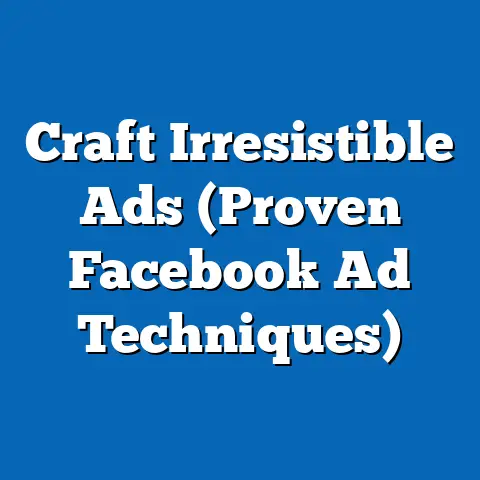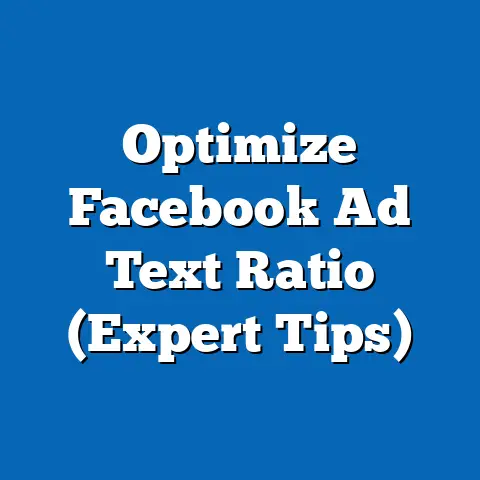Unlock Facebook CPAs for Skyrocketing Profits (Expert Guide)
In the early 20th century, the advent of radio transformed advertising, much like the rise of social media platforms such as Facebook has reshaped marketing in the 21st century. Just as radio allowed businesses to reach into the homes of millions with targeted messages during the 1920s and 1930s, platforms like Facebook have created unprecedented opportunities for precision targeting and cost-effective advertising through mechanisms like Cost Per Acquisition (CPA). This historical parallel underscores a key truth: each technological leap in communication reshapes how businesses connect with consumers, demanding new strategies and innovative thinking.
This article delves into the intricacies of unlocking Facebook CPAs to drive exceptional profits, exploring the mechanics of CPA advertising, historical context of digital marketing, key strategies for optimization, and the broader societal and economic implications. By blending data-driven insights with practical guidance, this expert guide aims to equip marketers, business owners, and digital strategists with the tools to maximize returns in an ever-evolving digital landscape.
Section 1: Understanding Facebook CPA – A Modern Marketing Metric
Cost Per Acquisition (CPA) is a critical metric in digital advertising, representing the cost a business incurs to acquire a customer or achieve a desired action, such as a purchase, sign-up, or download, through a specific campaign. On Facebook, CPA is often used within the broader framework of performance marketing, where advertisers pay only when a predefined goal is met, making it a highly efficient model for budget-conscious campaigns.
Unlike traditional metrics like Cost Per Click (CPC) or Cost Per Mille (CPM), CPA focuses on outcomes rather than interactions. This results-oriented approach mirrors a shift in advertising philosophy—away from mere exposure and toward measurable impact. As of 2023, Facebook (now under Meta) remains a dominant platform for CPA advertising, with over 2.9 billion monthly active users and sophisticated ad tools that allow granular targeting based on demographics, interests, and behaviors.
The significance of CPA lies in its alignment with return on investment (ROI). For businesses, especially small and medium enterprises (SMEs), optimizing CPA can mean the difference between a profitable campaign and a financial loss. However, achieving a low CPA requires a deep understanding of Facebook’s algorithms, audience behavior, and creative strategies—a challenge that this guide will address in detail.
Section 2: Historical Context – The Evolution of Digital Advertising
To fully appreciate the power of Facebook CPA advertising, it’s essential to contextualize its place within the broader history of digital marketing. The internet’s commercialization in the 1990s marked the birth of online advertising, with the first banner ad appearing on HotWired.com in 1994. This rudimentary form of advertising relied on impressions and clicks, with little focus on conversions or acquisitions.
The early 2000s saw the rise of search engine marketing, particularly through Google AdWords (now Google Ads), which introduced pay-per-click (PPC) models. This shift emphasized user intent, as ads were triggered by search queries, but it still lacked the personal targeting that social media would later provide. The launch of Facebook in 2004, followed by its advertising platform in 2007, revolutionized the industry by leveraging user data to deliver highly personalized ads.
By the 2010s, Facebook had become a powerhouse for performance marketing, introducing tools like Custom Audiences and Lookalike Audiences, which allowed advertisers to target users based on past interactions or similarities to existing customers. The concept of CPA gained traction as businesses sought measurable outcomes amidst increasing competition for digital ad space. Today, with privacy regulations like GDPR and Apple’s App Tracking Transparency (ATT) framework reshaping data collection, optimizing CPA on Facebook requires navigating a complex landscape of compliance and innovation—a dynamic reminiscent of earlier advertising pivots during regulatory changes in broadcast media.
Section 3: Key Defining Characteristics of Facebook CPA Campaigns
Facebook CPA campaigns are characterized by several distinct features that set them apart from other advertising models. First, they are outcome-driven, focusing on specific actions rather than broad metrics like reach or impressions. This makes CPA ideal for businesses with clear conversion goals, such as e-commerce sales or lead generation.
Second, CPA campaigns leverage Facebook’s advanced machine learning algorithms, which optimize ad delivery to users most likely to convert. The platform’s ability to analyze vast datasets in real time ensures that ad spend is directed toward high-value audiences, though this also means advertisers must continuously refine their targeting to avoid algorithmic biases or audience fatigue.
Third, CPA campaigns require a deep integration of creative and analytical elements. High-performing ads often combine compelling visuals, persuasive copy, and strategic calls-to-action (CTAs), while success metrics depend on rigorous A/B testing and data analysis. This dual focus on creativity and metrics distinguishes CPA from earlier, less sophisticated forms of digital advertising.
Finally, CPA campaigns are inherently flexible, allowing advertisers to set budgets and bid strategies based on their financial constraints and goals. However, this flexibility comes with complexity, as achieving a low CPA often involves balancing multiple variables, including audience segmentation, ad placement, and bidding models like manual versus automated optimization.
Section 4: Strategies for Unlocking Skyrocketing Profits with Facebook CPA
Achieving exceptional profits through Facebook CPA advertising requires a multifaceted approach that combines technical expertise, creative innovation, and data-driven decision-making. Below are key strategies to optimize CPA and maximize ROI.
4.1 Audience Targeting and Segmentation
Effective targeting is the cornerstone of a successful CPA campaign. Facebook offers a suite of tools, including Custom Audiences (based on existing customer data) and Lookalike Audiences (based on similarities to high-value users), to refine audience selection. Marketers should start by analyzing their customer data to identify high-performing segments, then use these insights to build tailored audiences.
It’s also critical to test different targeting parameters, such as age, location, interests, and behaviors, to uncover hidden opportunities. For instance, a 2022 study by WordStream found that narrowly targeted campaigns often achieve 26% lower CPAs compared to broad campaigns, highlighting the value of precision over reach.
However, over-segmentation can lead to diminishing returns, as overly small audiences may increase costs due to limited inventory. Striking a balance between specificity and scale is essential, as is staying updated on privacy changes that may impact targeting capabilities.
4.2 Creative Optimization
Ad creative plays a pivotal role in driving conversions and lowering CPA. High-quality visuals, engaging videos, and concise messaging can significantly improve click-through rates (CTR) and conversion rates. For example, carousel ads, which showcase multiple products or features, have been shown to reduce CPA by up to 30% for e-commerce brands, according to a 2021 report by Hootsuite.
Testing different creative formats—such as static images, videos, and interactive ads—helps identify what resonates with specific audiences. Additionally, incorporating dynamic ads, which automatically personalize content based on user behavior, can further enhance performance. The key is to maintain a consistent feedback loop, using performance data to iterate on creative elements continuously.
4.3 Bid Strategy and Budget Management
Facebook offers multiple bidding options for CPA campaigns, including lowest cost (automated) and target cost (manual control over CPA goals). Choosing the right strategy depends on campaign objectives and budget constraints. For instance, lowest cost bidding is ideal for maximizing conversions within a set budget, while target cost bidding suits advertisers aiming for consistent CPA over time.
Budget allocation also requires careful planning. A common mistake is underfunding campaigns during the learning phase, when Facebook’s algorithm is still optimizing delivery. Experts recommend allocating at least 50 conversions per ad set during this phase to ensure accurate data, as suggested by Meta’s own advertising guidelines.
4.4 Conversion Tracking and Attribution
Accurate tracking is non-negotiable for CPA optimization. The Facebook Pixel, a piece of code embedded on a website, enables advertisers to track user actions and attribute conversions to specific ads. Without proper tracking, CPA calculations may be skewed, leading to inefficient spend.
Moreover, understanding attribution models—such as last-click versus multi-touch—helps marketers allocate credit to the right touchpoints in the customer journey. With Apple’s ATT framework limiting cross-app tracking since 2021, advertisers must also explore alternative measurement tools, such as Meta’s Aggregated Event Measurement, to maintain accuracy in a privacy-first landscape.
4.5 Continuous Testing and Optimization
CPA campaigns thrive on experimentation. A/B testing different ad elements—such as headlines, images, and CTAs—provides actionable insights into what drives conversions. Similarly, testing different audience segments and placements (e.g., News Feed versus Stories) can uncover cost-effective opportunities.
Optimization should be an ongoing process, not a one-time effort. Regularly reviewing performance metrics like conversion rate, CTR, and relevance score allows marketers to identify underperforming ads and reallocate budget to top performers. Automation tools, such as Facebook’s Campaign Budget Optimization (CBO), can further streamline this process by dynamically adjusting spend across ad sets.
Section 5: Societal and Economic Implications of CPA Advertising
The rise of CPA advertising on platforms like Facebook has far-reaching implications for society, culture, and the economy. At its core, CPA reflects a broader shift toward accountability in marketing, where businesses prioritize measurable outcomes over speculative spend. This results-oriented approach benefits SMEs and startups by leveling the playing field, allowing smaller players to compete with larger brands through efficient ad spend.
However, the reliance on data-driven targeting raises ethical questions about privacy and consumer autonomy. High-profile scandals, such as the 2018 Cambridge Analytica incident, exposed how user data could be misused for manipulative advertising. As a result, regulators worldwide have introduced stricter privacy laws, forcing platforms like Facebook to adapt their ad models—a trend that impacts CPA strategies and costs.
Economically, CPA advertising fuels the growth of digital economies by enabling businesses to scale rapidly with minimal upfront investment. A 2022 report by eMarketer estimated that global digital ad spend reached $567 billion, with performance-based models like CPA accounting for a significant share. This democratization of advertising spend has also spurred job creation in fields like digital marketing and data analytics.
On the societal front, the personalization inherent in CPA campaigns can enhance user experiences by delivering relevant content, but it also risks creating echo chambers or reinforcing biases. For instance, algorithmic targeting may exclude certain demographics from seeing ads for opportunities like jobs or housing, as highlighted in a 2019 study by the U.S. Department of Housing and Urban Development. Addressing these challenges requires a balance between innovation and ethical responsibility—a debate that will shape the future of digital advertising.
Section 6: Challenges and Nuances in CPA Optimization
While CPA advertising offers immense potential, it is not without challenges. One major hurdle is the volatility of costs, influenced by factors like seasonality, competition, and platform algorithm updates. For example, CPAs often spike during high-demand periods like the holiday season, requiring advertisers to plan budgets accordingly.
Another challenge is the diversity of audience behavior across demographics and regions. A strategy that works for a younger, tech-savvy audience may fail with older users less accustomed to digital interactions. Similarly, cultural differences can affect ad reception, necessitating localized creative and messaging—a nuance often overlooked in global campaigns.
Privacy regulations add another layer of complexity. With data tracking limitations increasing, advertisers must pivot to first-party data strategies (e.g., collecting data directly from customers) and contextual targeting (e.g., placing ads based on content rather than user behavior). These shifts demand agility and a willingness to adapt, as the digital advertising landscape continues to evolve.
Section 7: Comparative Analysis – CPA Across Platforms
While this guide focuses on Facebook, it’s worth comparing CPA dynamics across other platforms like Google Ads, Instagram (also under Meta), and emerging players like TikTok. Google Ads, for instance, often yields lower CPAs for search-based campaigns due to high user intent, with average CPAs ranging from $20 to $50 across industries, per a 2023 WordStream report. However, Google lacks the social engagement and visual storytelling that Facebook excels at.
Instagram, while sharing Facebook’s ad infrastructure, often commands higher CPAs due to its younger, premium audience and emphasis on visual content. TikTok, on the other hand, offers lower CPAs for viral campaigns but requires a deep understanding of trends and short-form video—a barrier for some advertisers.
Each platform has unique strengths, and a multi-channel approach often yields the best results. For instance, using Facebook for retargeting and TikTok for brand awareness can create a synergistic effect, reducing overall CPA while maximizing reach. The key is to align platform choice with campaign goals and audience preferences.
Section 8: Future Outlook – The Next Frontier of CPA Advertising
Looking ahead, the future of Facebook CPA advertising will be shaped by several trends. First, advancements in artificial intelligence (AI) and machine learning will further refine ad optimization, enabling even more precise targeting and creative personalization. Meta’s ongoing investments in AI suggest that CPA campaigns will become increasingly automated, though human oversight will remain critical for strategy and ethics.
Second, the push for privacy will continue to redefine data usage. Advertisers will need to prioritize transparency and consent, building trust with consumers while exploring privacy-safe solutions like federated learning (a decentralized data processing method). This shift may initially increase CPAs as targeting becomes less granular, but long-term innovations could stabilize costs.
Third, the rise of immersive technologies like augmented reality (AR) and virtual reality (VR) could transform CPA campaigns. Meta’s focus on the metaverse hints at new ad formats and engagement metrics, potentially redefining what “acquisition” means in a virtual context. While these developments are speculative, they underscore the need for marketers to stay agile in a rapidly changing field.
Finally, economic uncertainties—such as inflation and recession risks—may impact ad budgets and consumer behavior, influencing CPA trends. Marketers must prepare for potential shifts in purchasing power and prioritize value-driven messaging to maintain conversion rates. While the future holds uncertainties, one thing is clear: adaptability will be the hallmark of successful CPA strategies.
Conclusion: Harnessing CPA for Sustainable Growth
Unlocking Facebook CPAs for skyrocketing profits is both an art and a science, requiring a blend of technical know-how, creative innovation, and strategic foresight. By understanding the historical evolution of digital advertising, mastering key optimization strategies, and navigating societal and ethical challenges, businesses can harness CPA to achieve remarkable ROI. However, success demands continuous learning and adaptation, as privacy regulations, technological advancements, and economic shifts reshape the digital landscape.
As we look to the future, the principles of accountability and efficiency embodied in CPA advertising will remain central to marketing success. Yet, the path forward will require balancing profitability with responsibility, ensuring that the pursuit of low CPAs does not come at the expense of consumer trust or societal equity. For marketers willing to embrace this challenge, Facebook CPA offers a powerful tool to drive growth in an increasingly connected world.






